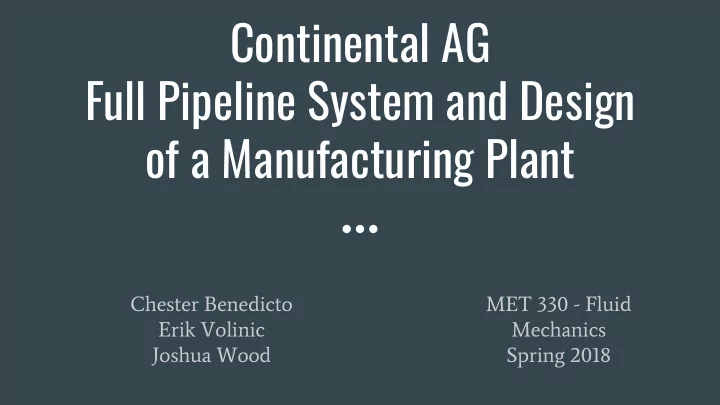

Continental AG Full Pipeline System and Design of a Manufacturing Plant Chester Benedicto MET 330 - Fluid Erik Volinic Mechanics Joshua Wood Spring 2018
Location Information ● Located in Dayton, Ohio ● Temperature Range: -20°F to 105°F ● Frost line: 30 inches below the surface
Manufacturing Plant Information 32 foot tall building,one story, concrete ● roof which can support a storage tank ● No storage tank except the 1000-gal reservoir can be inside the plant Plant operates for two shifts per day, 7 ● days a week. Maintenance is performed during the third shift
Coolant Information ● 15,000 gallons of coolant delivered by railroad tank car Dirty fluid is picked up by truck once per month ● Solution of water and soluble oil ● a. Specific Gravity = 0.94 b. Corrosiveness about the same as water c. Viscosity & Vapor Pressure = 1.5 * water @ any temperature
System Layout The coolant pipeline is a ● primarily gravity driven system. ● A single pump located between the railcar and the storage tank Tanks are located on the roof, ● inside, and next to the driveway of the factory.
Instrumentation Basic instrumentation includes the following: ● Pressure Gauge (US customary: lb/in^2) Flow Rate Gauge (US customary: gal/min) ● The pressure gauges are to be located at the bottom of each tank, and distance after each gate valve in the pipe layout. As for the flow rate gauges, with one being on a pipe that is the outlet of a tank, and another one at the inlet of the tank.
Pipe Fittings In the design process, we decided to use a minimal amount of parts throughout the system. Elbow: 90° elbow ● Gate Valves ● With the simplicity in mind, we were able to minimize the number of calculations for energy losses.
Blind Flange Design Design for future additional connections ● A-36 Steel ● ● Area of Flange: 0.00711 m^2 Flange Thickness : 1.74* 10^-4 m ● Bolt information Bolt size: ⅞ - 1 ½ in ● Total 4 bolts ●
Tank Specifications Tanks are given a cylindrical design. ● System is designed to hold maximum amount of coolant delivered. ● ● Reservoir tank is emptied weekly, along with emergency dumps. Storage Tank Reservoir Tank Waste Tank Cylinder Volumes 2,001.1945 133.6846 893.8145 (ft^3) Partial Cone Volume 104.4907 0.0000 108.7926 (ft^3) Total Volume (ft^3) 2,105.6852 133.6846 1,002.6071 Total Volume (gal) 15,751.5781 1,000.0275 7,500.0027
Flow Rates The flow rates were ● determined based on an 8-hour period, and each of the tanks storage capacities. OUTGOING TANK 1 TANK 2 TANK 3 TANK 4 TANK 5 FLOW RATE Flow Rate 34.4083 32.8158 2.0834 15.6250 N/A (gal/min) Flow Rate 0.0767 0.0731 0.0046 0.0348 N/A (ft^3/s)
Pipe Thickness When calculating the pipe thickness for each of the pipe systems, we derived our initial values from the iteration process from Tanks 2, 3, 4, and 5. And once we obtained the calculated interior diameter, we then referred to Table F.1 of the Schedule 40 Pipes in the: M. R. Untener, J.A, “Applied Fluid Mechanics”, 7th Edt, Pearson Education, (2015). And for safety purposes we went with the higher interior diameter to help regulate the coolant flow.
Pipe Supports For the majority of the support system, we chose to have the pipe to be hanged from either the wall, or from the ceiling. However, between the Reservoir and Waste Tank the pipeline is supported by standing Stanchion Pipe Support. As this section spans both inside and outside the building.
Open Channel System In case one tank fails and must be drained drained coolant goes to a drainage pond 500 feet from facility. Geometry: Rectangle ● Material: Painted Steel ● Dimensions: ● 1. 6000 in. length 2. 18 in. high 3. 18.55 in wide
Calculations The required calculations were mostly iteration based equations and summations. The extensive amount of iterations that were conducted was to be thorough, and ensure that our values were within a standardized percent error range. In the next slide there will be a sample of what our iterations looks like.
Energy Losses Pipe Values Storage to Reservoir (2 - 3) With the short list of different f D (ft) V Nr Re (D/e) New f % Diff parts used in our design; it was (ft/s) simple enough to calculate the 0.001 0.0516 34.8950 2.2174E+06 3.4434E+02 0.02603 -2,503 % energy losses ⎼ and their respected K and ƒ variables. 0.02603 0.0991 9.4748 1.1554E+06 6.6081E+02 0.02204 15.3069 % 0.02204 0.0958 10.1258 1.1945E+06 6.3922E+02 0.02221 -0.7877 % For the ƒ (Friction Factor), we utilized Microsoft Excel to 0.02221 0.0960 10.0956 1.1926E+06 6.4022E+02 0.02221 0.0372 % provide iterations for our given pipe system(s).
Energy Losses cont. The iteration process was repeated for 15 sets of calculations, and for the three remaining pipe layouts. With the exception for (1 - 2) where that is they pipe layout of where the pump is going to be located. Thus for the time being we set a distance from the train car to the inlet of the pump, and used the iteration process but named the iteration name to (1 - 2’) (One to Two Prime).
Pump Head When solving for the pump head, we referred to our iterations of (1 - 2’) which in turn provided us values to solve for the pump head, and to select our pump size.
Pump Requirements ● Flow rate into the pump is calculated 34.4083 gal/min. The pump head is 78.4611 ft. ● Power required is calculated as 39.6259 ● kW. The operating point of the pump is ● under the system curve, allowing the pump to operate in these conditions.
Pump Selection The chosen pump is a Sulzer ● centrifugal pump, designated 8x8x10-1 ● Only one pump is required between the railcar and storage tank
Bill of Materials Used to monitor the number and cost of materials and equipment included in the ● design of our system
Recommend
More recommend